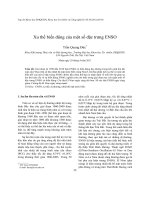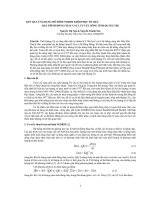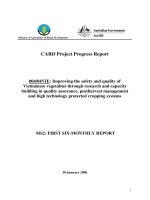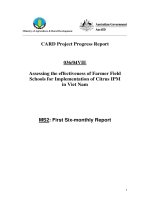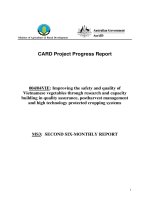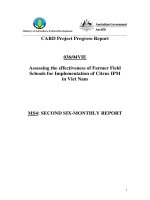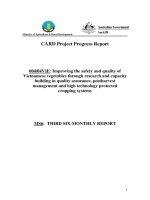Báo cáo nghiên cứu khoa học: "INVESTIGATING THE ECTOMYCORRHIZAL APPEARANCE OF SEEDLINGS IN TAN PHU FOREST ENTERPRISE’S NURSERY, DONG NAI PROVINCE" pdf
Bạn đang xem bản rút gọn của tài liệu. Xem và tải ngay bản đầy đủ của tài liệu tại đây (1.35 MB, 5 trang )
Science & Technology Development, Vol 11, No.01 - 2008
Trang 96
INVESTIGATING THE ECTOMYCORRHIZAL APPEARANCE OF
SEEDLINGS IN TAN PHU FOREST ENTERPRISE’S NURSERY, DONG NAI
PROVINCE
Pham Nguyen Duc Hoang, Dang Le Anh Tuan
University of Natural Sciences, VNU-HCM
(Manuscript Received on April 15
th
, 2007)
ABSTRACT: In the scope of Project “Emphasize natural forest patrimony of Dong Nai
Province - Management and Enrichment of Tan Phu forest”, we investigated the
ectomycorrhizal appearance of seedlings in Tan Phu forest enterprise’s nursery which will be
mainly used to reforest in Dong Nai province. Randomly choosing and morphology analyzing
45 seedlings of 9 species of Dipterocarpaceae and Fabaceae show that 8 of 9 species have
ectomycorrhiza. Only seedlings of Dalbergia bariensis Pierre in the nursery are not
ectomycorrhizal but nodulate. This research helps to evaluate the adaptive ability of seedlings
in nursery to the field conditions when they are planted in Tan Phu forest enterprise.
Key words:
ecomycorrhiza (ECM), Dipterocarpaceae, Fabaceae, Hartig net, mantle
extraradical hyphae
1.INTRODUCTION
Dipterocarpaceae and Fabaceae, as the families of plants, perhaps hold the distinction of
being the most well-known trees in the tropical forests. They pre-dominate the international
tropical timber market for ages, and therefore play an important role in the economy of many
of the Southeast Asian countries (Poore, 1989). In addition, there are many types of non-wood
forest products (NWFPs) from dipterocarps such as dammar, resin and camphor which have a
critical impact on the economies of rural people’s income.
Recently, the two families are gaining more attention, specially planting either in
plantations or in poor forests. Many valuable species of these families become exhausted with
every passing day because of over-logging and/or degrading. Otherwise, so many species in
Fabaceae and Dipterocapaceae have an absolutely ectomycorrhizal symbiosis which plays the
critical role in the life of forest trees and influents the survived and mature ability of seedlings.
Therefore, reseach on mycorrhizas as well as their association with dipterocarps has gained a
high profile.
2.MATERIALS AND METHODS
2.1.Materials
The seedlings are collected randomly from Tan Phu forest enterprise’s nursery. All of
seedlings are cultivated from the seeds which are collected from the mother trees in Tan Phu
forest. They are the same 2 years old and cultivated in plastic bags with the soil taken arround
the mother trees.
The seedlings are in nine specises of two family (Fabaceae, Dipterocarpaceae): Afzelia
xylocarpa (Kurz) Craib, Dalbergia bariensis Pierre, Sindora siamensis Teysm. ex Miq. var.
siamensis, Dipterocarpus alatus Roxb., Dipterocarpus dyeri Pierre, Dipterocarpus turbinatus
Gaertn.f., Hopea odorata Roxb., Shorea roxburghii G. Don, Shorea thorelii Pierre.
TẠP CHÍ PHÁT TRIỂN KH&CN, TẬP 11, SỐ 01 - 2008
Trang 97
2.2.Methods
The root systems of seedlings are cleared of soil with tap water (M.Brundrett et al, 1996;
A.Yamada, 1996) immediately after being taken out of nursery, and then stored in alcohol.
Some lengths are chosen by macro-character from the root system of every seedling and
sectioned (M.Brundrett et al, 1996).
Roots are sectioned, stained by trypan blue (M.Brundrett et al, 1996) and observed the
micro-morphology in light microscope Westlab II. We check about mantle, Hartig net, and the
extraradical hyphae which are the special micro-characters specialized for ectomycorrhiza
(Smith and Read, 1997; Peterson, 2004; Agerer, 2006). Mantle is the general character which
is mainly used to check ectomycorrhiza (Peterson, 2004; Agerer, 2006).
3.RESULTS
Table 1.
The ectomycorrhizal appearance of seedlings
No. Family Species Total
Ectomycorrhiza
Appearance
1 Afzelia xylocarpa 5 5
2 Dalbergia bariensis 5 0
3
Fabaceae
Sindora siamensis 5 5
4 Dipterocarpus alatus 5 5
5 Dipterocarpus dyeri 5 5
6 Dipterocarpus turbinatus 5 5
7 Hopea odorata 5 5
8 Shorea roxburghii 5 5
9
Dipterocarpaceae
Shorea thorelii 5 5
Seedlings of all species in Dipterocarpaceae, Fabaceae except D. bariensis (Fig.2b) have
ectomycorrhiza. However, D. bariensis has a structure which is like endomycorrhiza (Fig.2a)
and all of seedlings are nodulated (Fig.2c).
The mantle of all species which are ectomycorrhizal can be viewed clearly except D.
turbinatus because of brittle sections (Fig.6). Some species such as A. xylocarpa, H. odorata,
S. roxburghii have thick mantle (Fig.1, 7, 8) but some others have thin mantle as D. dyeri and
S. thorelii (Fig.5, 9). Hartig net can not be observed clearly in seedlings of some species of S.
siamensis and D. dyeri (Fig. 3, 5). Extraradical hyphae is viewed in A. xylocarpa, D. alatus, H.
odorata, S. roxburghii (Fig.1, 4, 7, 8) in a few sections only.
Science & Technology Development, Vol 11, No.01 - 2008
Trang 98
M
H
Hy
M
M
H
Endomycorrhiza-liked
M
Not has
mantle
Hy
H
M
Hy
H
Not has
mantle
H
M
Hy
M
M
H
H
TẠP CHÍ PHÁT TRIỂN KH&CN, TẬP 11, SỐ 01 - 2008
Trang 99
Fig. 1. Afzelia xylocarpa Fig. 2. Dalbergia bariensis
Fig. 2a. endomycorrhiza-liked structure 2b. not ectomycorrhiza 2c. nodule
Fig. 3. Sindora siamensis Fig. 4. Dipterocarpus alatus Fig. 5. Dipterocarpus dyeri
Fig. 6. Diptercarpus turbinatus Fig. 7. Hopea odorata Fig. 8. Shorea roxburghii
Fig. 9. Shorea thorelii (M) mantle (H) Hartig net (Hy) hyphae
4.CONCLUSION
The genus Afzelia, Dipterocarpus, Hopea and Shorea are recorded that having some
ectomycorrhizal species (Smith and Read, 1997; Molina, Massicotte and Trape, 2002).
Particularly, it has the ectomycorrhizal appeared record in D. alatus (Appanah, 1998), H.
odorata (Appanah, 1998; See, 1994) and S. roxbughii (Appanah, 1998; Kanchanaprayudh,
2003). Therefore, the ectomycorrhizal records of A. xylocarpa, D. alatus, D. dyeri, D.
turbinatus, H. odorata, S. roxburghii, S. thorelii in this study are corresponding with previous
researches. The ectomycorrhizal appearrance in S. siamensis is still recorded by diagnostic
characters which are specified ectomycorrhiza.
The most obvious micro-character is mantle because it is the general character to
investigate ectomycorrhiza of plant roots (Peterson, 2004).
All seedlings of 8 of 9 species having ectomycorrhiza in this study show that soil around
mother trees has got many ectomycorrhizal germs suitable with them. Moreover, the
ectomycorrhizal seedlings may have the high adaptation with field conditions of Tan Phu
forest. Therefore, they have high survival ability when are planted in Tan Phu forest.
H
M
Hy
H
M
M
Hy
H
Science & Technology Development, Vol 11, No.01 - 2008
Trang 100
KHẢO SÁT SỰ HIỆN DIỆN NGOẠI KHUẨN CĂN Ở CÂY CON THUỘC HỌ
DẦU (DIPTEROCARPACEAE) VÀ HỌ ĐẬU (FABACEAE) TẠI VƯỜN ƯƠM
LÂM TRƯỜNG TÂN PHÚ, TỈNH ĐỒNG NAI
Phạm Nguyễn Đức Hoàng, Đặng Lê Anh Tuấn
Trường Đại học Khoa học Tự nhiên, ĐHQG-HCM
TÓM TẮT: Trong phạm vi của dự án “Phục hồi và phát triển di sản rừng tự nhiên của
tỉnh Đồng Nai - Quản lý và cải thiện rừng Tân Phú”, chúng tôi khảo sát sự hiện diện khuẩn
căn ở cây con trong vườn ươm nhằm tái tạo rừng tại lâm trường Tân Phú. Chọn ngẫu nhiên
tại vườm ươm, giải phẫu rễ và quan sát hình thái hiển vi và thô đại 45 cây con của 9 loài
thuộc họ Dầu (Dipterocapaceae) và họ Đậu (Fabaceae) cho thấy 8/9 loài trên có sự hi
ện diện
của ngọai khuẩn căn. Loài Dalbergia bariensis tại vườm ươm không có rễ nấm nhưng qua
quan sát thấy xuất hiện nốt sần rễ đậu. Kết quả của nghiên cứu hỗ trợ đánh giá khả năng thích
ứng của cây con trong vườn ươm khi được trồng trong tự nhiên rừng Tân Phú.
REFERENCES
[1]. Agerer, R, Fungal relationship and structural identity of their ectomycorrhizae.
Mycol Progess 5: 67-107pp, (2006).
[2].
Appanah, S., J. M. Turnbull. The review of Dipterocarps, taxonomy, ecology and
silviculture. CIFOR. 220 p, (1998).
[3].
Brundrett, M., N. Bougher, B. Dell, T. Grove, N. Malajczuk. Working with
mycorrhizas in forestry and agriculture. Autralian Centre for International
Agriculture Research (ACIAR). 179-201pp, (1996).
[4].
Kanchanaprayudh, J., Z. Zhou, S. Yomiart, P. Sihanonth, T. Hogetsu. Molecular
phylogeny of ectomycorrhizal Pisolithus fungi associated with pine, dipterocarp and
eucalyptus trees in Thailand. Mycoscience 44: 287-294pp, (2003).
[5].
Molina, R., H. Massicotte, J.M. Trappe. Specificity phenomena in mycorrhizal
symbioses: community-ecological consequences and practical implications. In M.F.
Allen (ed.), Mycorrhizal Functioning An Integrative Plant-Fungal Process. Chapman
& Hall, London. 357-423pp, (1992).
[6].
Peterson, R.L., H.B. Massicotte, L.H. Melville. Mycorrhizas: anatomy and cell
biology. National Research Council Research Press. 7-42pp, (2004).
[7].
Poore, D No timber without trees: sustainability in tropical forest. Earthscan
Publications, London. 252p, (1989).
[8].
See, L.S., I.J. Alexander. The respone of seedlings of dipterocarp species to nutrient
additions and ectomycorrhizal infection. Plant and Soil 163: 299-306 pp, (1994).
[9].
Smith, S.E., D.J. Read. Mycorrhizal symbiosis. Academic Press. 163-233pp, (1997).
[10].
Yamada A., K. Katsuay. Morphological classification of ectomycorrhiza of Pinus
densiflora. Mycosciences 37: 145-155pp, (1996).



